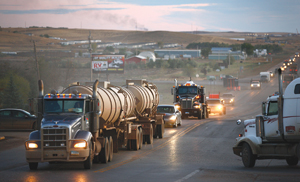FMCSA to Address Uptick in Crashes in North Dakota’s Bakken Oil Region

This story appears in the Jan. 26 print edition of Transport Topics.
The Federal Motor Carrier Safety Administration said it is addressing an increasing and disproportionate number of fatal large truck-involved crashes in North Dakota’s Bakken oil field counties.
Jack Van Steenburg, FMCSA’s chief safety officer, said the agency has identified a “large cluster” of crashes in the oil field operations in North Dakota, one of the nation’s largest crude oil production states.
“We have some strategies and we’re working with other departments to reduce those crashes,” Van Steenburg said.
Federal crash statistics show that the number of fatal large truck-involved crashes had increased to 54 in 2013 from 9 in 2010.
Many of the crashes in North Dakota occurred on two major highways where oil trucks run, U.S. 85 and Interstate 94, Van Steenburg said.
“It’s an area of concern for FMCSA, the North Dakota Highway Patrol, and everyone in the state,” said Denver Tolliver, professor of transportation and director of North Dakota State University’s transportation and logistics program. “The FMCSA has concluded that the heavy-vehicle crashes and crash rates were increasing faster in the Bakken than they were in some of the other shale oil boom regions, such as Eagle Ford in Texas.”
FMCSA is increasing oversight of tank truck carriers that haul crude oil and propane, giving its investigators advanced training, issuing grants to states, and stepping up traffic enforcement, according to Paul Bomgardner, chief of FMCSA’s hazardous materials division.
“Moving forward we’re going to . . . focus our attention, actually on the transportation of energy products,” Bomgardner told an audience attending the annual conference of the Transportation Research Board in Washington, D.C., on Jan. 13. “What are we going to do? More oversight, more oversight, more oversight.”
“We’re going to be initiating a series of studies over the next year or so to not only look at where these accidents are located, but try to get a better idea of some of the cause and effect,” Tolliver said.
According to recent research by the Upper Great Plains Transportation Institute, a research, education, and outreach center at North Dakota State University, roads once used for local access and agricultural purposes now mostly serve expanding oil production.
“Oil companies, workers, commercial trucks, and industrial equipment associated with oil extraction use these roads to access oil drilling and production sites,” the group said.
In its 2013 report, the state’s highway patrol said it has “strived” to meet the demands of the growing motor carrier industry operations.
“The need to move goods across the country and between points within North Dakota remains at an all-time high,” the highway patrol report said.
“The issue is between 2008 and 2013, vehicle miles traveled in the state — and mostly in that Bakken region of in our state — increased by about three billion miles,” said Arik Spencer, executive vice president of the North Dakota Motor Carriers Association. “So you have a huge number of people traveling on infrastructure that [it] was never designed to hold.”
Congestion on state, county and local roads has increased to the point that it too frequently causes motorists to get impatient, passing on hills when traffic slows and exhibiting other dangerous driving behaviors, Spencer said.
With oil trucks traveling on the state’s highways and rural roads, the state’s current budget for infrastructure maintenance, repair and rebuilding has grown to nearly $3 billion from $1 billion in 2007, Spencer said.
Staff Reporter Eugene Mulero contributed to this story.

